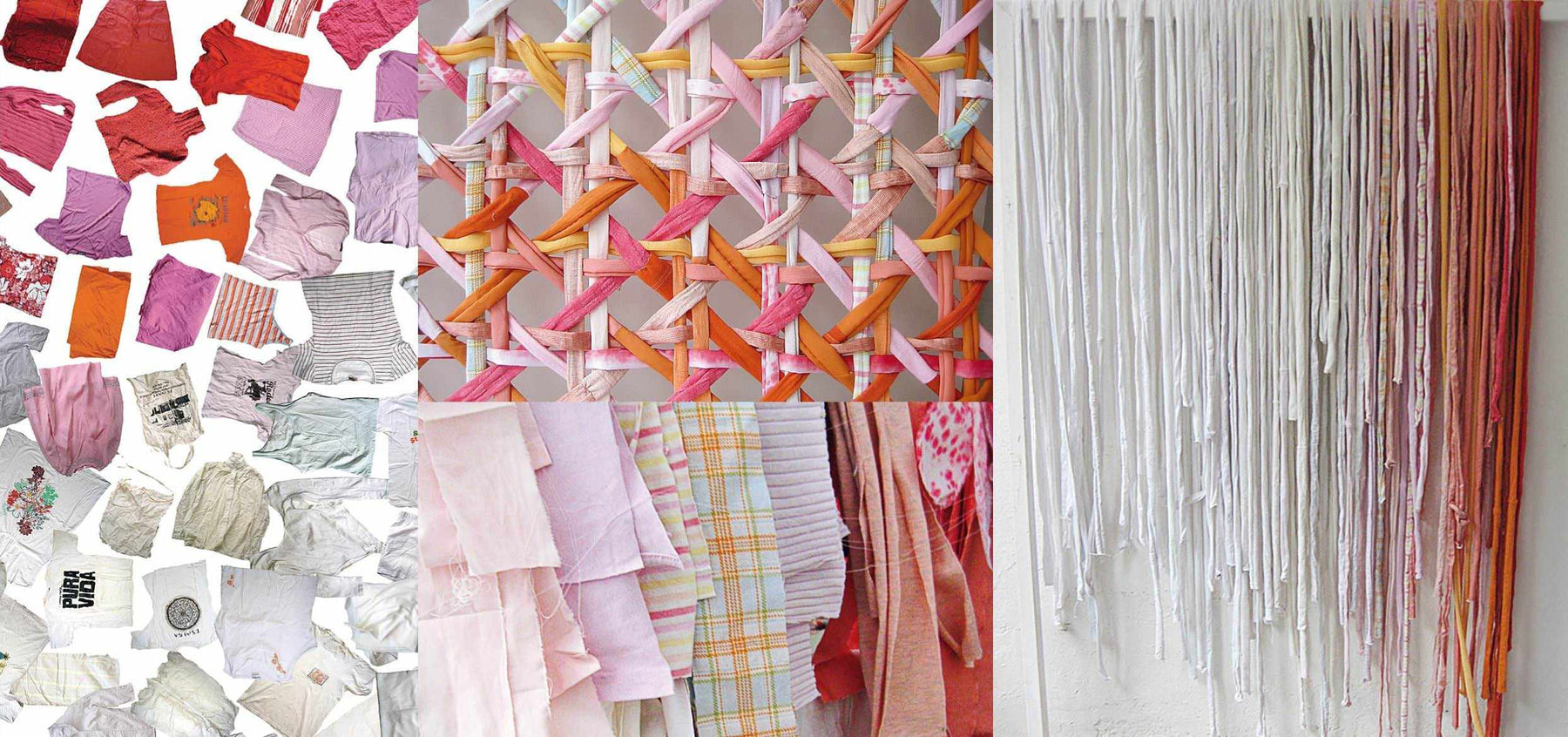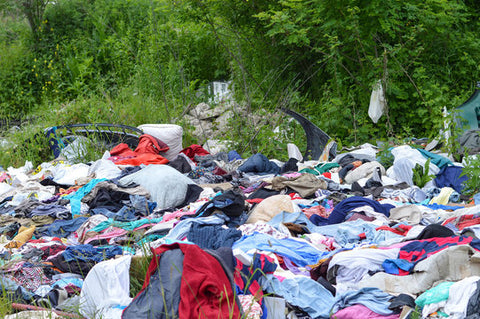
The Sustainable Alternatives for Polyester You Need To Know

How to replace fabrics made from polyester, nylon, and other synthetic fibres with biodegradable or recycled options to optimise sustainability
The first synthetic fibres, in a long history of textile and clothing, were only invented in the 30s and 40s. American company DuPont invented nylon in 1935, and two scientists working for the Calico Printers' Association (a British textile company founded in 1899 and based in Manchester) created polyester in 1941. Unlike manmade natural fibres, which derive from natural components like plants (such as cotton and linen) or animals (wool, leather, silk) and are inherently biodegradable; polyester, nylon, and other synthetic fibres are petroleum-based, which makes them stronger -- amongst other profitable qualities.

The Rise Of Polyester
Wrinkle and tear-resistant, presenting very little shrinking, and being a cheaper -- not to mention faster -- textile to produce, it is no surprise that in less than 100 years, synthetic fibres came to dominate the textile industry with over 60% of its share, according to the 2018 "Preferred Fibre and Materials Market Report" from Textile Exchange.. Their popularity, however, is proving to have damaging consequences for the planet, and though it might sound challenging, there are plenty of sustainable options to choose from if we want to keep both the environment and the industry healthy. Starting with recycled fibres might be a good idea.
The prediction is for that market share to rise even further. PCI Fibres calculates that by 2030 polyester might have a demand of 70 millions of tons, and other -- more pessimistic -- statistics believe that number to reach 90 millions of tons, significantly growing faster than all other fibre types. That parcel of the market and its steady increase, however, represent a well-known peril for the environment: not only synthetic fibres have a larger carbon-print, they also require harmful dyes most of the times, and release microplastic particles (through washing) that are rapidly accumulating in the ocean. Being synthetic, they are not biodegradable and contaminate not only the water but the wildlife. But what exactly are the types of synthetic fabrics?
Polyester
This type of synthetic fibre is the most widely used and is produced mainly in China and India. Around 98% of all future fibre growth is expected to be in synthetic fibres, and 95% of which is expected to be polyester, according to the "Global Fibres Overview: Synthetic Fibres Raw Material Committee Meeting" in 2014. Inexpensive and long-lasting, the material is stain-resistant, easy to wash, and can be blended with natural fibres -- which makes it more appealing but difficult or almost impossible to recycle. (Recycling 100% polyester is an equal challenge since the mechanical process of recycling it [or any plastic in general] usually results in lower quality material every time, and chemical recycling is still expensive). Pure polyester can shed around 496,030 plastic microfibres per wash, against 137,951 from a polyester-cotton blend, according to a 2016 investigation by Plymouth University called "Release of Synthetic Microplastic Plastic Fibres From Domestic Washing Machines: Effects of Fabric Type and Washing Conditions". It is commonly used in clothing, fillings, and carpets.

Nylon
The first ever created synthetic fibre was used to replace silk in women's stockings, reaching the market in 1940. During World War II, all the nylon production was used in military parachutes, rope, and tents. This synthetic fibre is very durable, light, and malleable; used today in the production of swimwear and sportswear for its quick-drying properties, or in luggage, carpets and cars. Recycled nylon can already be found in lots of swimwear brands.

Acrylic
Its warmth giving properties made it a popular replacement for wool, but it can also be draped and dyed in bright colours. Used to make outdoor goods, clothing, and carpets. This type of synthetic textile unleashes the most plastic microfibres, around 730,000 per wash, says the research by Plymouth University.
Elastane
These fibres -- well-known for their commercial names, Lycra and Dorlastan --, stretch from 4 to 7 times their length, always returning to their original shape. This type of elasticity makes it an excellent choice for swimwear, sportswear, and underwear. It dries quickly, it's light and very comfortable to wear, but it is not biodegradable. (Note: in the US, elastane fibres are often called spandex).

Sustainable Alternatives
Your garments' materials are one of the easiest places to start with sustainability. Even with the inevitable growth of polyester, considering sustainable, biodegradable, or recycled textiles are a healthier choice not only for the environment but also for whole communities involved in the textile industry. The eco-friendly fabric options are plenty, and their impact is overwhelming and urgent.
Recycled Synthetic Fibres
A mere 0.07% sustainable fibre used as part of the overall synthetic production is equivalent to saving 2.9 billion plastic bottles from landfills ("Preferred Fibre and Materials Market Report", 2018, by Textile Exchange). The tiny percentage has an evident sustainability impact, and more companies have started to invest their time and resources to make their processes eco-friendlier. Spanish outerwear brand Ecoalf, for instance, recycles plastic bottles, tyres, and fishing nets, turning them into winter coats, jackets, and even trainers and flip-flops in a project called "Upcycling the Oceans" with bases in Spain and Thailand. The revolutionary idea is simple: work with local fishermen to collect marine debris and upcycle it into threads, then turned into garments. They collect almost 1 ton of plastic waste every day.

Another major player is Adidas, who is pledging to eliminate all "virgin plastic" in its products, including polyester, by 2024, according to the Financial Times. Instead, the company is committed to investing in recycled plastics only: the SS19 collection already uses 41% recycled polyester, developed by reusing plastic waste and/or existing synthetic textile fibres, and in 2017 the German brand sold 1 million shoes with recycled plastic from the ocean. Water-efficient and with a lower fossil fuel consumption, the recycled material is a viable and sustainable choice and an important textile trend that has seen incredible and positive Research & Development news for the industry.
There is a lot of controversy about recycled synthetic fibres as they still release a percentage of plastic microfibres through washing. However, given the volume of plastic material in our ocean, recycled synthetic fibres contribute to recycling what would otherwise be considered waste, making it a sustainable alternative. In some fashion industry areas like sportswear or swimwear, for example, natural fibres will rarely perform in a similar way, making recycled synthetics a better option, if not the only (also to prevent more exploration of our natural resources) Their use and investment in research, as we will see, is bringing a recycled, sustainable and biodegradable future closer and closer. Guppyfriend™, for instance, is a washing bag that protects synthetic garments and avoids the microfibres to be released in the water.
Econyl®
Endless renovation without any waste of resources: that's the premise from Econyl. A product from Aquafil, a company that talked about more its technology during Fashinnovation, and supplies regenerated nylon made from nylon waste from landfills and oceans around the world. It can be recycled and recreated over and over again, closing the resourcing loop and making it infinitely sustainable (this process is called closed-loop recycling). Stella McCartney, Adidas and Speedo are amongst the adepts of the performance fabric, which can also be used in architecture (as insulation) and decoration (carpets and floor coverings).
This regenerated nylon reduces the global warming impact of nylon by up to 80% compared to non-recycled versions made directly from oil.
PrimaLoft
The company has recently introduced PrimaLoft Bio Performance Fabric, a 100% recycled, and, most importantly, biodegradable polyester expected to be commercially available from fall 2020. Its fibres break down when exposed to specific environments – the landfill or the ocean -- because they are made more attractive to the microbes present in these environments, eliminating the waste at a faster rate. Their first recycled polyester synthetic insulation product came out in 2016 and was first used by outerwear brand Patagonia, a large investor in recycled synthetics.
Manmade and Natural Fibres
How did we dress before polyester and other synthetic fibres came along? The answer is easy: with naturally biodegradable choices like cotton, linen, and leather. Those options can also be sustainable, especially when choosing to buy organic and/or local. Manmade natural fibres -- like Tencel and lyocell blends -- focus on sustainability too, as they do not come from petrochemical polymers (but wood pulp) which makes them more environmentally friendly than their fossil fuel polymer counterparts.
In general, the sustainable fabric sourcing will invest in textiles that are made from recycled fibres, keeping an eye on the innovative textile technology that allows new products to replace or recycle the ubiquitous synthetic fibres like polyester and nylon.
